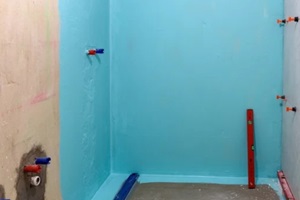 When extreme weather strikes, commercial buildings equipped with proactive Delaware commercial waterproofing measures suffer far less destruction than their unprotected counterparts. Wind, rain, floodwaters, heavy snow, and ice readily exploit vulnerable spots in roofs, windows, doors, and foundations.
When extreme weather strikes, commercial buildings equipped with proactive Delaware commercial waterproofing measures suffer far less destruction than their unprotected counterparts. Wind, rain, floodwaters, heavy snow, and ice readily exploit vulnerable spots in roofs, windows, doors, and foundations.
However, strategic waterproofing fortifies weaknesses, bolstering structural resilience against collapse or failure. For commercial property owners, proper waterproofing is essential to emergency preparedness.
Common Threats to Commercial Buildings in Delaware
Delaware’s mid-Atlantic location exposes it to intense weather events throughout the year. Let’s look at some of the most common threats that commercial structures may face:
- Hurricanes and tropical storms – While Delaware rarely takes a direct hurricane hit, these systems often rake the state with damaging high winds, storm surge flooding along the coast, and tremendous rainfall as they pass offshore.
- Severe thunderstorms – With hot, humid summers and clashing cold fronts, severe thunderstorms frequently strike Delaware. These storms unleash hail capable of battering buildings, straight-line winds over 58 mph that can tear off roofs and collapse walls, and extreme rainfall that overwhelms drainage systems and floods structures.
- Blizzards and ice storms – Delaware winters fluctuate between mild and punishing. The state endures paralyzing blizzards and ice storms when cold air combines with ample moisture off the Atlantic. Pounding snow loads can cause roof collapse if reinforcement is lacking. Significant ice buildup topples trees onto buildings and brings down power lines.
- Flooding – Situated near sea level, Delaware is prone to flooding along its coastline from storm surges and inland from sudden downpours or overflowing rivers. Commercial buildings not properly elevated or shielded often suffer catastrophic water damage when floodwaters rise.
Vulnerabilities in Commercial Structures
To brace for emergencies through Delaware commercial waterproofing, it helps to know the weak points shared by many commercial buildings:
- Roofing – Roofs lacking sturdy reinforcement can fail under heavy snow loads or uplift from high winds, allowing torrential water influx. Flat roofs are especially vulnerable to pooling water if drainage is poor.
- Windows – Large pane windows in many commercial buildings can shatter under strong winds or flying debris. Once broken, they provide an open passage for wind and rain to rush in and cause interior damage.
- Entryways/Loading docks – Doors, loading docks, and garage doors facing the brunt of the storm are prone to blowout failure, giving floodwaters a direct channel into a building.
- Basements – Underground basements readily flood unless fully waterproofed due to groundwater seepage and surface overflow. Trapped moisture spurs mold growth and can float essentials such as hot water heaters.
- Outdated materials – Worn roofing, dried-out sealants, eroded masonry, and other deteriorated building materials are less able to withstand storms, accelerating failure.
- Gaps/Cracks – Small gaps where materials join or cracks from shifting/settling provide entry points for wind and water when not properly sealed against the elements.
Emergency Prep Through Waterproofing
 Now that you know where commercial buildings are most at risk during weather emergencies, how can Delaware commercial waterproofing shore up these vulnerabilities before disaster strikes?
Now that you know where commercial buildings are most at risk during weather emergencies, how can Delaware commercial waterproofing shore up these vulnerabilities before disaster strikes?
Professional Assessment
Start by having an experienced commercial waterproofing contractor assess your building. They can identify weak areas and custom design a waterproofing plan to target them.
Strategic Use of Waterproofing Materials
Professionals have a range of waterproofing weapons in their arsenal. Flexible rubberized membranes can be adhered over vulnerable areas to repel moisture. Masonry sealants fill cracks and gaps while allowing needed ventilation.
Silane or siloxane coatings shield building exteriors against driving rain while letting interior moisture escape. Strategic application of the proper materials for each area waterproofs without trapping moisture inside.
Maintaining/Upgrading Roofing and Flashing
Your roof takes the brunt of every storm, so keeping it in top shape is essential. Inspect for leaks, damage, and deterioration regularly. Upgrade to impact-resistant shingles or roofing membranes. Make sure flashing around roof protrusions is watertight. Improve drainage and secure loose elements.
Waterproofing Basements and Foundations
For maximum flood protection, coat basement walls with waterproofing compounds or membranes. Look for interior drainage systems and sump pumps to keep the basement dry if groundwater seeps in. Reinforce foundations with commercial sealants to prevent shifting.
Reinforcing Doors, Windows, and Entryways
Install wind-rated doors and windows to withstand blows and debris. Anchor them firmly in masonry. Use rubberized flashing membranes around windows and commercial sealants around doors/garages to seal out driving rain.
Additional Emergency Measures
Beyond waterproofing, some other preparations can further boost a structure’s resilience:
 Secure any outdoor elements such as signs, seating, and lighting that could turn into dangerous projectiles in high winds.
Secure any outdoor elements such as signs, seating, and lighting that could turn into dangerous projectiles in high winds.- Test sump pumps and clear floor drains before storms to handle heavy rainfall.
- Safeguard important inventory and equipment by elevating off basement floors and covering if possible.
- Review emergency and evacuation protocols with staff so everyone knows their role.
- Have contingency plans for business operations if the building sustains damage.
Prepare with Delaware’s Top Commercial Waterproofing Professionals
Don’t leave your commercial property vulnerable when the next big storm approaches Delaware. Waterproof Caulking & Restoration’s extensive experience in assessing, repairing, and protecting all types of buildings means our team can help you implement a customized commercial waterproofing plan to ready your property for whatever nature throws its way.
Contact us today at 484.265.9646 or schedule a consultation online to start your journey toward emergency preparedness through advanced Delaware commercial waterproofing.
